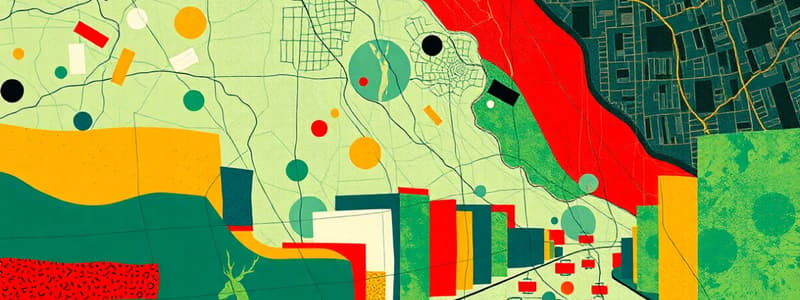Podcast
Questions and Answers
शहरी विकास में कौन सा कारक सबसे महत्वपूर्ण है, जो नौकरियों, उद्योगों और आर्थिक विकास को सुनिश्चित करता है?
शहरी विकास में कौन सा कारक सबसे महत्वपूर्ण है, जो नौकरियों, उद्योगों और आर्थिक विकास को सुनिश्चित करता है?
- सामाजिक कारक
- राजनीतिक कारक
- आर्थिक कारक (correct)
- पर्यावरणीय कारक
शहरों के भौतिक रूप और संरचना का अध्ययन क्या कहलाता है, जिसमें सड़कों, इमारतों और खुले स्थानों का विश्लेषण शामिल है?
शहरों के भौतिक रूप और संरचना का अध्ययन क्या कहलाता है, जिसमें सड़कों, इमारतों और खुले स्थानों का विश्लेषण शामिल है?
- शहरी पारिस्थितिकी
- शहरी नवीनीकरण
- शहरी आकारिकी (correct)
- शहरी योजना
शहरी क्षेत्रों में आवश्यक सेवाओं और सुविधाओं, जैसे परिवहन, पानी और ऊर्जा ग्रिड को क्या कहा जाता है, जो शहरी जीवन का समर्थन करते हैं?
शहरी क्षेत्रों में आवश्यक सेवाओं और सुविधाओं, जैसे परिवहन, पानी और ऊर्जा ग्रिड को क्या कहा जाता है, जो शहरी जीवन का समर्थन करते हैं?
- शहरी बुनियादी ढांचा (correct)
- शहरी नवीनीकरण
- स्मार्ट शहर
- शहरी शासन
शहरी नियोजन का प्राथमिक उद्देश्य क्या है, जो आर्थिक विकास, सामाजिक समानता और पर्यावरणीय संरक्षण को संतुलित करता है?
शहरी नियोजन का प्राथमिक उद्देश्य क्या है, जो आर्थिक विकास, सामाजिक समानता और पर्यावरणीय संरक्षण को संतुलित करता है?
वह प्रक्रिया क्या है जिसमें धनी लोग ऐतिहासिक रूप से गरीब शहरी क्षेत्रों में जाकर संपत्ति मूल्यों में वृद्धि करते हैं?
वह प्रक्रिया क्या है जिसमें धनी लोग ऐतिहासिक रूप से गरीब शहरी क्षेत्रों में जाकर संपत्ति मूल्यों में वृद्धि करते हैं?
भूगोल में 'स्थान' की अवधारणा क्या दर्शाती है, जो किसी क्षेत्र को अद्वितीय पहचान प्रदान करती है?
भूगोल में 'स्थान' की अवधारणा क्या दर्शाती है, जो किसी क्षेत्र को अद्वितीय पहचान प्रदान करती है?
कौन सा कारक शहरी विकास को प्रभावित नहीं करता है?
कौन सा कारक शहरी विकास को प्रभावित नहीं करता है?
शहरी फैलाव का मुख्य कारण क्या है, जो शहरों के अनियंत्रित विस्तार को दर्शाता है?
शहरी फैलाव का मुख्य कारण क्या है, जो शहरों के अनियंत्रित विस्तार को दर्शाता है?
स्थिर शहरी विकास का उद्देश्य क्या है?
स्थिर शहरी विकास का उद्देश्य क्या है?
स्मार्ट शहरों का मुख्य लक्ष्य क्या है, जो प्रौद्योगिकी और डेटा का उपयोग करते हैं?
स्मार्ट शहरों का मुख्य लक्ष्य क्या है, जो प्रौद्योगिकी और डेटा का उपयोग करते हैं?
कौन सा शहरी घटनाक्रम सामाजिक समानता और सामर्थ्य के बारे में चिंताएँ बढ़ाता है?
कौन सा शहरी घटनाक्रम सामाजिक समानता और सामर्थ्य के बारे में चिंताएँ बढ़ाता है?
शहरी नियोजन में क्षेत्रीय नियमों का क्या उद्देश्य है?
शहरी नियोजन में क्षेत्रीय नियमों का क्या उद्देश्य है?
शहरी नवीनीकरण परियोजनाओं से क्या चिंताएँ उत्पन्न हो सकती हैं?
शहरी नवीनीकरण परियोजनाओं से क्या चिंताएँ उत्पन्न हो सकती हैं?
शहरी गरीबी से निपटने के लिए कौन सी रणनीति आवश्यक है?
शहरी गरीबी से निपटने के लिए कौन सी रणनीति आवश्यक है?
शहरी पारिस्थितिकी में किसका अध्ययन किया जाता है?
शहरी पारिस्थितिकी में किसका अध्ययन किया जाता है?
परिवहन योजना का मुख्य उद्देश्य क्या है?
परिवहन योजना का मुख्य उद्देश्य क्या है?
आवास नीतियाँ क्या प्रभावित करती हैं?
आवास नीतियाँ क्या प्रभावित करती हैं?
सार्वजनिक स्थानों का शहरों में क्या महत्व है?
सार्वजनिक स्थानों का शहरों में क्या महत्व है?
शहरी लचीलापन का क्या अर्थ है?
शहरी लचीलापन का क्या अर्थ है?
शहरी क्षेत्रों में प्रवास का मुख्य कारण क्या है?
शहरी क्षेत्रों में प्रवास का मुख्य कारण क्या है?
Flashcards
भूगोल क्या है?
भूगोल क्या है?
धरती के भू-भागों, वातावरणों और लोगों और उनके परिवेश के बीच की बातचीत का अध्ययन।
शहरी विकास क्या है?
शहरी विकास क्या है?
शहरी क्षेत्रों में होने वाली वृद्धि, विस्तार और परिवर्तन, जिसमें शहर और कस्बे शामिल हैं।
स्थान क्या है?
स्थान क्या है?
पृथ्वी पर पूर्ण (निर्देशांक) और सापेक्ष (अन्य स्थानों के संबंध में) स्थिति।
जगह (Place) क्या है?
जगह (Place) क्या है?
Signup and view all the flashcards
मानव-पर्यावरण बातचीत क्या है?
मानव-पर्यावरण बातचीत क्या है?
Signup and view all the flashcards
आवागमन क्या है?
आवागमन क्या है?
Signup and view all the flashcards
क्षेत्र क्या है?
क्षेत्र क्या है?
Signup and view all the flashcards
शहरीकरण क्या है?
शहरीकरण क्या है?
Signup and view all the flashcards
शहरीकरण के कारक क्या हैं?
शहरीकरण के कारक क्या हैं?
Signup and view all the flashcards
शहरी फैलाव क्या है?
शहरी फैलाव क्या है?
Signup and view all the flashcards
सतत शहरी विकास क्या है?
सतत शहरी विकास क्या है?
Signup and view all the flashcards
शहरी नियोजन क्या है?
शहरी नियोजन क्या है?
Signup and view all the flashcards
जेंट्रीफिकेशन क्या है?
जेंट्रीफिकेशन क्या है?
Signup and view all the flashcards
शहरी बुनियादी ढाँचा क्या है?
शहरी बुनियादी ढाँचा क्या है?
Signup and view all the flashcards
शहरी शासन क्या है?
शहरी शासन क्या है?
Signup and view all the flashcards
स्मार्ट शहरें क्या हैं?
स्मार्ट शहरें क्या हैं?
Signup and view all the flashcards
शहरी नवीनीकरण क्या है?
शहरी नवीनीकरण क्या है?
Signup and view all the flashcards
शहरी गरीबी क्या है?
शहरी गरीबी क्या है?
Signup and view all the flashcards
स्थानिक विश्लेषण क्या है?
स्थानिक विश्लेषण क्या है?
Signup and view all the flashcards
परिवहन योजना क्या है?
परिवहन योजना क्या है?
Signup and view all the flashcards
Study Notes
- Geography studies the Earth's landscapes, environments, and the interactions between people and their surroundings.
- Urban development refers to the growth, expansion, and changes that occur in urban areas, including cities and towns. It involves physical, economic, social, and environmental transformations.
Key Concepts in Geography
- Location: Absolute (coordinates) and relative (in relation to other places) positioning on Earth.
- Place: Physical and human characteristics creating unique identities.
- Human-Environment Interaction: How people adapt to, modify, and depend on the environment.
- Movement: The flow of people, goods, ideas, and information.
- Region: Areas with unifying characteristics (physical, human, cultural).
Urbanization
- Urbanization is the process by which rural areas become urbanized as populations move from rural to urban areas.
- It is often driven by economic opportunities, better services (healthcare, education), and social factors.
- Rapid urbanization can lead to challenges such as overcrowding, inadequate infrastructure, and social inequality.
Factors Influencing Urban Development
- Economic factors: Availability of jobs, industries, and economic growth prospects.
- Social factors: Education, healthcare, cultural attractions, and community services.
- Political factors: Government policies, urban planning regulations, and investments in infrastructure.
- Environmental factors: Natural resources, climate, and environmental quality.
- Technological factors: Innovations in transportation, communication, and construction.
- Demographic factors: Population growth, migration patterns, and age structure.
Urban Planning
- Urban planning involves the design and management of urban spaces to promote sustainable and livable communities.
- It includes zoning regulations, transportation planning, housing policies, and environmental management.
- Effective urban planning aims to balance economic development, social equity, and environmental protection.
Urban Sprawl
- Urban sprawl is the uncontrolled expansion of urban areas into surrounding rural areas.
- It is characterized by low-density development, reliance on automobiles, and segregation of land uses.
- Sprawl can lead to increased traffic congestion, environmental degradation, and loss of agricultural land.
Sustainable Urban Development
- Sustainable urban development aims to create cities that meet the needs of the present without compromising the ability of future generations to meet their own needs.
- It involves promoting compact, mixed-use development, investing in public transportation, and protecting green spaces.
- Sustainable cities prioritize resource efficiency, renewable energy, and social inclusion.
Urban Morphology
- Urban morphology studies the physical form and structure of cities and towns.
- It examines the arrangement of streets, buildings, and open spaces, and how they evolve over time.
- Understanding urban morphology can inform urban planning and design decisions.
Gentrification
- Gentrification is the process by which wealthier people move into historically poorer or working-class urban neighborhoods.
- It can lead to increased property values, displacement of existing residents, and changes in the cultural character of the neighborhood.
- Gentrification is often accompanied by improvements in infrastructure and services, but also raises concerns about social equity and affordability.
Urban Infrastructure
- Urban infrastructure includes essential services and facilities that support urban life.
- It includes transportation networks, water supply and sanitation systems, energy grids, and communication networks.
- Adequate urban infrastructure is crucial for economic development, public health, and quality of life.
Urban Governance
- Urban governance refers to the systems and processes by which cities are managed and governed.
- It involves the roles and responsibilities of local governments, citizens, and other stakeholders.
- Effective urban governance is essential for addressing urban challenges and promoting sustainable development.
Smart Cities
- Smart cities use technology and data to improve the efficiency, sustainability, and livability of urban areas.
- They leverage sensors, networks, and data analytics to optimize services, reduce waste, and enhance citizen engagement.
- Smart city initiatives can include intelligent transportation systems, smart energy grids, and data-driven decision-making.
Urban Renewal
- Urban renewal is the process of redeveloping blighted or deteriorated areas of a city.
- It often involves demolition of existing buildings, construction of new infrastructure, and attracting private investment.
- Urban renewal projects can transform neighborhoods, but also raise concerns about displacement and community disruption.
Urban Poverty
- Urban poverty refers to the concentration of poverty in urban areas.
- It is often associated with lack of access to employment, education, healthcare, and affordable housing.
- Addressing urban poverty requires комплексные стратегии that include job creation, social support programs, and affordable housing initiatives.
Urban Ecology
- Urban ecology examines the interactions between living organisms and the urban environment.
- It studies the impact of urbanization on biodiversity, ecosystem services, and human health.
- Urban ecology informs urban planning and design decisions that promote ecological sustainability.
Spatial Analysis
- Spatial analysis is a set of techniques used to analyze and understand spatial patterns and relationships.
- It involves using geographic information systems (GIS) and other tools to visualize, analyze, and model spatial data.
- Spatial analysis is used in urban planning, transportation planning, and environmental management.
Transportation Planning
- Transportation planning focuses on designing and managing transportation systems to meet the needs of urban residents and businesses.
- It involves planning for roadways, public transportation, bicycle infrastructure, and pedestrian facilities.
- Effective transportation planning aims to reduce traffic congestion, improve accessibility, and promote sustainable transportation options.
Housing Policies
- Housing policies are government regulations and programs that affect the availability, affordability, and quality of housing.
- They include zoning regulations, rent control, housing subsidies, and affordable housing development programs.
- Effective housing policies aim to ensure that all residents have access to decent, safe, and affordable housing.
Public Spaces
- Public spaces are areas in cities that are open and accessible to all members of the public.
- They include parks, plazas, streets, and community centers.
- Public spaces play a vital role in social interaction, recreation, and community building.
Urban Resilience
- Urban resilience refers to the ability of cities to withstand and recover from stresses and shocks, such as natural disasters, economic crises, and social unrest.
- It involves building adaptive capacity, strengthening infrastructure, and promoting social cohesion.
- Resilience planning aims to minimize the impacts of future disruptions and ensure the long-term sustainability of cities.
Studying That Suits You
Use AI to generate personalized quizzes and flashcards to suit your learning preferences.




